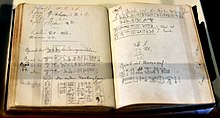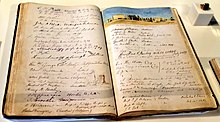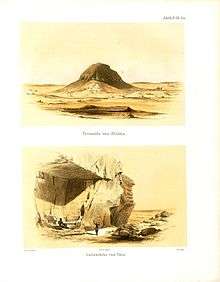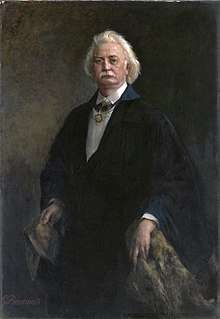Karl Richard Lepsius
Karl Richard Lepsius (Latin: Carolus Richardius Lepsius) (23 December 1810 – 10 July 1884) was a pioneering Prussian egyptologist, linguist and modern archaeologist.
Karl Richard Lepsius | |
|---|---|
.jpg) Karl Richard Lepsius | |
| Born | 23 December 1810 |
| Died | 10 July 1884 (aged 73) Berlin, Province of Brandenburg |
| Nationality | Prussian, German |
| Awards | |
| Scientific career | |
| Fields | Egyptology |
| Signature | |
 | |
Biography
Karl Richard Lepsius was the son of Karl Peter Lepsius, a classical scholar from Naumburg, and his wife Friederike (née Gläser), who was the daughter of composer Carl Ludwig Traugott Gläser.[1] The family name was originally "Leps" and had been Latinized to "Lepsius" by Karl's paternal great-grandfather Peter Christoph Lepsius.[2] He was born in Naumburg on the Saale, Saxony.[3]
Early life
He studied Greek and Roman archaeology at the University of Leipzig (1829–1830), the University of Göttingen (1830–1832), and the Frederick William University of Berlin (1832–1833). After receiving his doctorate following his dissertation De tabulis Eugubinis in 1833, he travelled to Paris, where he attended lectures by the French classicist Jean Letronne, an early disciple of Jean-François Champollion and his work on the decipherment of the Egyptian language, visited Egyptian collections all over Europe and studied lithography and engraving.
Work


After the death of Champollion, Lepsius made a systematic study of the French scholar's Grammaire égyptienne, which had been published posthumously in 1836 but had yet to be widely accepted. In that year, Lepsius travelled to Tuscany to meet with Ippolito Rosellini, who had led a joint expedition to Egypt with Champollion in 1828-1829. In a series of letters to Rosellini, Lepsius expanded on Champollion's explanation of the use of alphabetic signs in hieroglyphic writing, emphasizing (contra Champollion) that vowels were not written.
In 1842, Lepsius was commissioned (at the recommendation of the minister of instruction, Johann Eichhorn, and the scientists Alexander von Humboldt and Christian Charles Josias Bunsen) by King Frederich Wilhelm IV of Prussia to lead an expedition to Egypt and the Sudan to explore and record the remains of the ancient Egyptian civilization. The Prussian expedition was modelled after the earlier Napoleonic mission, with surveyors, draftsmen, and other specialists.[4] The mission reached Giza in November 1842 and spent six months making some of the first scientific studies of the pyramids of Giza, Abusir, Saqqara, and Dahshur. They discovered 67 pyramids recorded in the pioneering Lepsius list of pyramids and more than 130 tombs of noblemen in the area.[4] While at the Great Pyramid of Giza, Lepsius inscribed a graffito written in Egyptian hieroglyphs that honours Friedrich Wilhelm IV above the pyramid's original entrance; it is still visible.[5] (photos and translation) In 1843 he visited Naqa and copied some of the inscriptions and representations of the temple standing there.[6]
Working south, stopping for extended periods at important Middle Egyptian sites, such as Beni Hasan and Dayr al-Barsha, Lepsius reached as far south as Khartoum, and then traveling up the Blue Nile to the region about Sennar. After exploring various sites in Upper and Lower Nubia, the expedition worked back north, reaching Thebes on November 2, 1844, where they spent four months studying the western bank of the Nile (such as the Ramesseum, Medinet Habu, the Valley of the Kings, etc.) and another three on the east bank at the temples of Karnak and Luxor, attempting to record as much as possible. Afterwards they stopped at Coptos, the Sinai, and sites in the Egyptian Delta, such as Tanis, before returning to Europe in 1846.

The chief result of this expedition was the publication of Denkmäler aus Aegypten und Aethiopien (Monuments from Egypt and Ethiopia),[7] a massive twelve volume compendia of nearly 900 plates of ancient Egyptian inscriptions, as well as accompanying commentary and descriptions. These plans, maps, and drawings of temple and tomb walls remained the chief source of information for Western scholars well into the 20th century, and are useful even today as they are often the sole record of monuments that have since been destroyed or reburied. For example, he described a "Headless Pyramid" that was subsequently lost until May 2008, when a team led by Zahi Hawass removed a 25-foot-high sand dune to re-discover the superstructure (base) of a pyramid believed to belong to King Menkauhor.
Upon his return to Europe in 1845, he married Elisabeth Klein in 1846 and was appointed as a professor of Egyptology at Berlin University in the same year, and the co-director of the Ägyptisches Museum in 1855; after the death of Giuseppe Passalacqua in 1865, he was director of the museum. In 1866 Lepsius returned to Egypt, where he discovered the Decree of Canopus at Tanis, an inscription closely related to the Rosetta Stone, which was likewise written in Egyptian (hieroglyphic and demotic) and Greek.
Lepsius was president of the German Archaeological Institute in Rome from 1867–1880, and from 1873 until his death in 1884, the head of the Royal Library at Berlin. He was the editor of the Zeitschrift für ägyptische Sprache und Altertumskunde, a fundamental scientific journal for the new field of Egyptology, which remains in print to this day. While at the editorial helm, Lepsius commissioned typographer Ferdinand Theinhardt (on behalf of the Prussian Academy of Sciences) to cut the first hieroglyphic typeface, the so-called Theinhardt font, which remains in use today.
Lepsius published widely in the field of Egyptology, and is considered the father of the modern scientific discipline of Egyptology, assuming a role that Champollion might have achieved had he not died so young. Much of his work is fundamental to the field. Indeed, Lepsius even coined the phrase Totenbuch ("Book of the Dead"). He was also a leader in the field of African linguistics, though his ideas are now mainly considered to be outdated. Based on his work in the ancient Egyptian language, and his field work in the Sudan, Lepsius developed a Standard Alphabet for transliterating African Languages; it was published 1855 and revised in 1863. His 1880 Nubische Grammatik mit einer Einleitung über die Völker und Sprachen Afrika's contains a sketch of African peoples and a classification of African languages, as well as a grammar of the Nubian languages.
Family
On 5 July 1846, he married Elisabeth Klein, (1828–1899), daughter of the composer Bernhard Klein and great-granddaughter of Friedrich Nicolai. They had six children, including the geologist and Rector of the Darmstadt University of Technology G. Richard Lepsius (1851–1915), the chemist and director of the Chemical Factory Griesheim Bernhard Lepsius (1854–1934), the portrait painter and member of the Prussian Academy of Arts (as of 1916) Reinhold Lepsius (1857–1929) and the youngest son Johannes Lepsius, Protestant theologian, humanist and Orientalist.
Major works

- 1842. Das Todtenbuch der Ägypter nach dem hieroglyphischen Papyrus in Turin mit einem Vorworte zum ersten Male herausgegeben. Leipzig: Georg Wigand. (Reprinted Osnabrück: Otto Zeller Verlag, 1969)
- 1849. Denkmäler aus Ägypten und Äthiopien nach den Zeichnungen der von Seiner Majestät dem Könige von Preußen Friedrich Wilhelm IV nach diesen Ländern gesendeten und in den Jahren 1842–1845. ausgeführten wissenschaftlichen Expedition auf Befehl Seiner Majestät herausgegeben und erläutert. 13 vols. Berlin: Nicolaische Buchhandlung. (Reprinted Genève: Éditions de Belles-Lettres, 1972)
- 1852. Briefe aus Aegypten, Aethiopien und der Halbinsel des Sinai geschrieben in den Jahren 1842–1845 während der auf Befehl Sr. Majestät des Königs Friedrich Wilhelm IV von Preußen ausgeführten wissenschaftlichen Expedition. Berlin: Verlag von Wilhelm Hertz (Bessersche Buchhandlung). Translated into English 1853 Discoveries in Egypt, Ethiopia and the Peninsula of Sinai. London: Richard Bentley. (Reissued by Cambridge University Press, 2010. ISBN 978-1-108-01711-4)
- 1855. Das allgemeine linguistische Alphabet. Grundsätze der Übertragung fremder Schriftsysteme und bisher noch ungeschriebener Sprachen in europäische Buchstaben. Berlin: Verlag von Wilhelm Hertz (Bessersche Buchhandlung)
- 1856. Über die XXII. ägyptische Königsdynastie nebst einigen Bemerkungen zu der XXVI. und andern Dynastieen des neuen Reichs. Berlin: Gedruckt in der Druckerei der königl. Akademie der Wissenschaften Internet Archive. Translated into English 1858: The XXII Egyptian Royal Dynasty, with some remarks on the XXIV and other Dynasties of the New Kingdom. London: John Murray (Republished by Cambridge University Press, 2010. ISBN 978-1-108-01739-8)
- 1860. The Gospel of Mark in the Fiadidja dialect of Nubian also called the Nobiin language. Published in Berlin in 1860. Then edited by Leo Reinisch, and republished by the British and Foreign Bible Society in 1885.
- 1863. Standand Alphabet for Reducing Unwritten Languages and Foreign Graphic Systems to a Uniform Orthography in European Letters, 2nd edition, London/Berlin. (Republished by John Benjamins, 1981. With an introduction by J. Alan Kemp. doi:10.1075/acil.5)
- 1880. Nubische Grammatik mit einer Einleitung über die Völker und Sprachen Afrika's. Berlin: Verlag von Wilhelm Hertz
Death
He suffered from stomach ulcers which became cancerous. After five weeks of eating little, he died without pain at 9 am on 10 July 1884.[8]
See also
- Lepsius list of pyramids
- Standard Alphabet by Lepsius
- Wilhelm Heinrich Immanuel Bleek
References
- Citations
- Lepsius 1854, pp. 9-10.
- Lepsius 1854, p. 9.
- Lepsius 1993, p. 316.
- Peck 2001, p. 289.
- Orcutt, Larry (2002). "GP Hieroglyphics". Retrieved 18 February 2005.
- Clammer 2005, pp. 128–31.
- Lutze, Gerald; Schulz, Christine; Franke, Lothar (2004). "Denkmäler aus Ägypten und Äthiopien". Universitäts- und Landesbibliothek Sachsen-Anhalt. Retrieved 17 February 2005.
- Ebers 1887, p. 280-81.
Sources
- Clammer (2005). Sudan. Bradt Travel Guides. ISBN 978-1-84162-114-2.CS1 maint: ref=harv (link)
- Ebers, Georg (1887). Richard Lepsius; a biography. Translated by Underhill, Zoe Dana. New York: William S. Gottsberger.CS1 maint: ref=harv (link)
- Lepsius, Karl Peter (1854). Kleine Schriften: Beiträge zur thüringisch-sächsischen Geschichte und deutschen Kunst- und Alterthumskunde (in German). 1st Vol. R. Kretschmann. Magdeburg: Albert Schulz.CS1 maint: ref=harv (link)
- Lepsius, Mario Rainer (1993). Demokratie in Deutschland : soziologisch-historische Konstellationsanalysen : ausgewählte Aufsätze. Vol. 100. Göttingen: Vandenhoeck & Ruprecht. ISBN 352535763X.CS1 maint: ref=harv (link)
- Peck, William H. (2001). "Lepsius, Karl Richard". In Redford, Donald B. (ed.). The Oxford Encyclopedia of Ancient Egypt, Volume 2. Oxford University Press. pp. 289–290. ISBN 978-0-19-510234-5.CS1 maint: ref=harv (link)
External links
| Wikimedia Commons has media related to Karl Richard Lepsius. |
| Wikisource has the text of a 1905 New International Encyclopedia article about Karl Richard Lepsius. |
- Works by or about Karl Richard Lepsius at Internet Archive
- Chisholm, Hugh, ed. (1911). . Encyclopædia Britannica. 16 (11th ed.). Cambridge University Press. p. 481.
- Lepsius Archiv: archival material from Lepsius' 1842–1845 expedition to Egypt and Nubia
- Lepsius Project: Denkmäler aus Aegypten und Aethiopien: Lepsius' 12 volume masterwork on the inscriptions of ancient Egypt and Nubia; still useful today